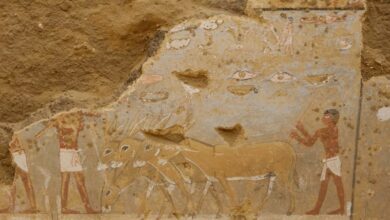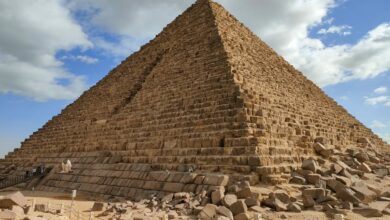One of the most comprehensive works published about Egypt celebrating its 200th birthday, La Description d’Egypte, on display at the Invalides in Paris until September 19th, offers a glimpse of the inspiration that sparked modern Egyptology and a wave of Orientalism
It is literally a text and visual description of Egypt, the likes of which have never been matched. La Description compiles notes, sketches of buildings, people and animals, as well as color reproductions (such as the bas relief from Medinet Habu accompanying this article). About 160 civilian scientists, called savants, accompanied General Napoleon and his troops to Egypt. Eventually, nearly 200 engravers in France reproduced the work of 62 draughtsmen, and consumed about 2,200,000 sheets of paper for printing plates alone.
"For Egyptologists the [La Description] volumes mark the first systematic, scientific recording of Egypt’s ancient monuments, and represents the beginning of all later scientific documentation (and epigraphy) in Egypt," says Raymond Johnson, the director of the Epigraphic Survey of the Oriental Institute of the University of Chicago, "the achievement is all the more remarkable considering that Egyptian hieroglyphs had not been translated yet."
Approaching the exhibition borrowed from the Louvre–under the gilded dome of the Invalides–La Description appears relatively small. It only contains a slight fraction of the 7,000 pages of La Description’s exhaustive 11 volumes. The exhibit is displayed above and to the side of Napoleon’s massive tomb, however, which has eight of his greatest conquests, including Egypt, written in stone on the ground. The quartzite tomb was intended to resemble red porphyry, a granite quarried only in Egypt, used in the tombs of Roman emperors–of which Napoleon fashioned himself to be.
"By the beauty and the sheer size of its pages, [La Description] represents a masterpiece of French publication; it is one of the most beautiful monuments erected to honor the glory of Napoleon, rightfully presented next to the tomb of the emperor," explains Yves Laissus, the curator of the exhibition and Honorary Inspector General of Libraries.
"Despite the limited surface area of the exhibition space, I feel that the presentation contains enough information to allow the visitor to comprehend–if not the work’s total content–at least the monumentality of the work; the presence of the furniture literally supporting the volumes emphasizes this character," Laissus wrote in a email to Al Masry Al Youm.
Laissus says that the exhibition is more about the intellectual work of Napoleon’s exhibition than the journey itself. Yet La Description is a testament to Napoleon’s foresight in Egypt to transform his first major military campaign as a ruler–a defeat–into his empire. Although some 50 per cent of his troops were stranded and many died of illnesses, he had planned his return early. Depending on which story of history you believe, Napoleon returned from Egypt simply to ascend to power or he fled to Palestine after defeat at Abukir by the British navy and Mamlouk troops. Regardless of how he left, he used Egypt as the launching pad of his empire.
Within only a few years after returning to France, he seized power as first council, institutionalized the revolution, and established the Napoleonic code and the Legion of Honor. La Description was first published in 1809, but was not fully released until 1829, thirty years after Napoleon landed in Egypt. It took the world by storm.
At the U.S. National Constitution Center in Philadelphia, an exhibit of Napoleon’s life and personal items includes pieces from La Description.
"The astonishing visual feast of ancient Egyptian art presented in the volumes ignited the imagination of its readers and launched a wave of Egyptomania throughout the world not seen since Roman times," notes Johnson. "Architecture, furniture, and even the minor arts were all influenced by the ancient Egyptian art captured in those volumes."
Pharaonic obelisks inspired the Washington Monument, for example, which was dedicated to US war heroes, just as those in ancient times celebrated the pharaohs.
"Who would have thought of Napoleon as the intermediary between Egypt and America?" asks Steve Frank, vice president of education and exhibits of the constitution center.
La Description remains one of the greatest cultural publications in history. "It opened the door to the Middle East, and remains the rock from which all present, scientific work in Egypt was launched," Johnson says. "It is venerated by all as a bridge between the West and East, past and present."
"La Description de l’Egypte" is on display at the Invalides in Paris until September 21. More information can be found at: http://www.invalides.org/pages/program.html
"Napoleon" is on display at the National Constitution Center in Philadelphia until September 9. More information can be found at: http://www.constitutioncenter.org/napoleon/




